#learning skills
Text
One of the hardest things about starting to paint minis, especially fancy characters I'm really invested in, is how do you know when you're done? With writing it's easy, because of what I write (short fiction) and how I write (linearly with a little line editing during drafting); it's easy to go "ah, I've gotten to the end, it's done." But there could be more details on Abaddon! a better blood splatter under this Possessed! more glowy eyes! more nuanced shading! How do you figure out when you should just put it down?
I have a terrible suspicion the answer is "practice, and you'll get a feel for it."
27 notes
·
View notes
Text
Good day everyone :)
This week's garden update~
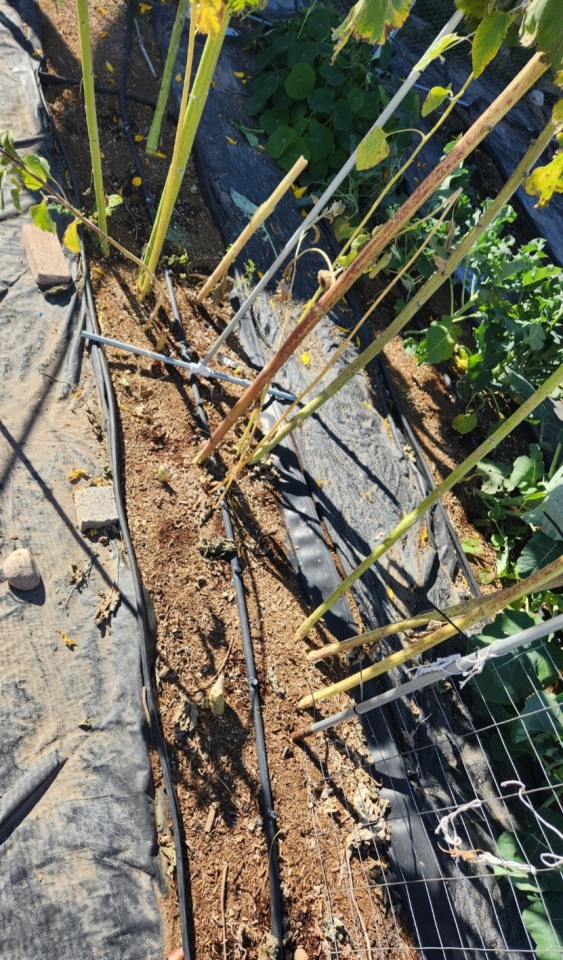
The beans and pumpkin that grew with the sunflowers are gone now and I've begun thinning out the sunflowers as the seeds get selected by birds.
I like to leave the smaller heads for the smaller native birds of the area. The heads i save, I've been setting into a drying rack where no birds can get to them.
The stalks I've been discarding the leaves in our cities green barrel (compost) program and I'm saving the stalks to either burn, or to chunk up and try a Hügelkultur grow bed. Not sure 100% what will eb grown in it, might be flowers or herbs, maybe strawberries.

This is currently the biggest sunflower yet! That pole is about 6ft off ground. I'll definatly need a ladder when it's time to take a few of the heads.
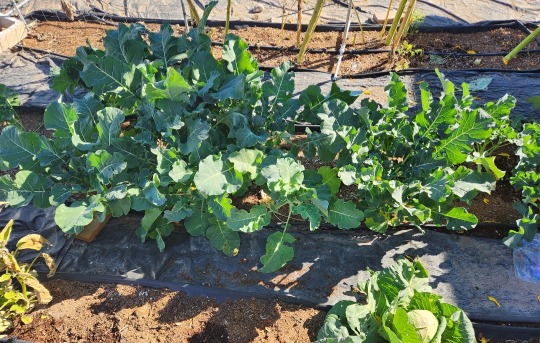
The broccoli row, there's some little florets now on most the plants! :D
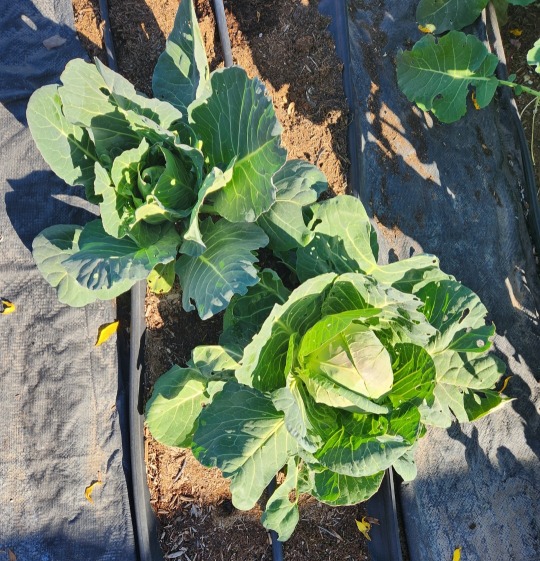
Cabbages, all four are similarly headed now.
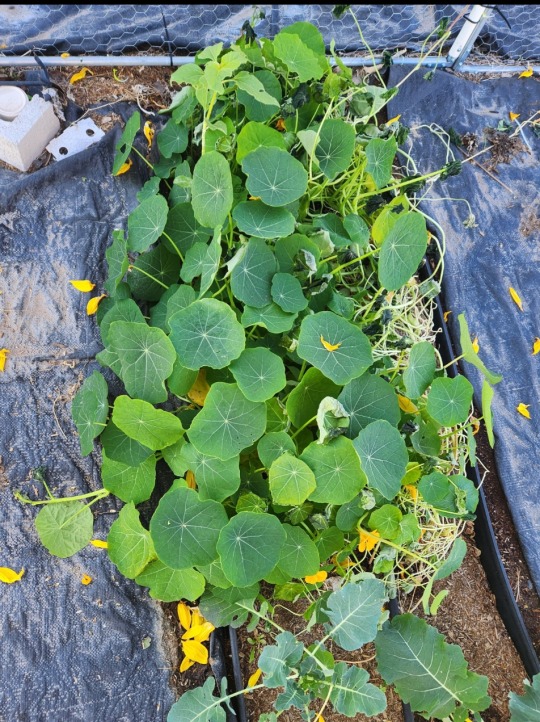
The nasturtium, which i need to go through and clean up a bit. The cold did get one side of em pretty sharply.
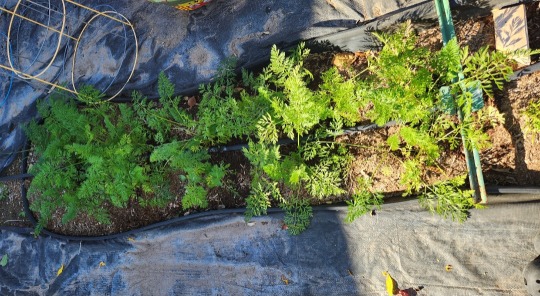
The carrots.
This is the batch I used the cornstarch planting method. So far, while they lined up real nice I feel like they aren't growing as well as i hoped. Now weather that's the seed, the planting spot or the season/weather I'm not entirely sure. I think I'll do a summer grow as well, just to test it out again.
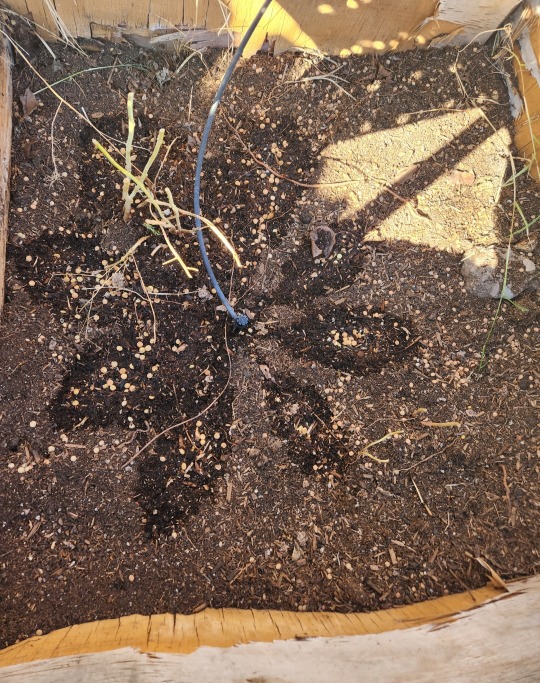
The back 'l" bed, ive direct seeded some lentils with the asparagus. I intend to grow the lentils then till them back in to the soil. We were going to dump this bed, but it seems we like it still so we'll likely be doctoring it up for a few more seasons.
Well thats it for now :)
🌱🌻Happy Homesteading and Gardening 🌻🌱
1 18 2024
#homesteading#self sufficient living#thestudentfarmer#studentfarmer#self sufficiency#food#garden#gardening#low waste#chickens#right to grow food#urban homesteading#urban gardening#urban farming#urban biodiversity#grow what you can#learning skills#going green as can be#cabbage#grow cabbage#sunflowers#live with nature#urban green spaces#urban growth#green space#carrots#grow carrots#edible landscaping#edible yards
7 notes
·
View notes
Text
Language Learners 🗣
Topic: Gender Nouns
The language tips that I provide are usually in English/Spanish however, you can still apply your target language in the examples below because my language tips are for everyone and all levels. So, let’s end our introduction and start learning! This exercise focuses on your listening skills and helps you add more vocabulary to your vernacular. Remember to speak in your target language the same way you would speak in your native language which is with a strong, confident pronunciation.

Are you having difficulties learning a language? What if I told you that learning a language is not as difficult as you think. If you want to master your target language then all you have to do is be open-minded. Some languages have gender nouns while others do not. If your native tongue is English and you have encountered a word in another language like "la mesa" then you might be confused, but before you roll your eye to the side in disgust you should know that English used to be a gendered language until the Middle English period.
Masculine vs. Feminine Nouns
What is your gender? If someone were to speak about you then they would say he or she and these nouns work the same way. Think of these words as people and call them by their appropriate gender.
What's the difference?
Depending on the language depends on their rules for masculine and feminine nouns. In Spanish if the word ends in o it is masculine and if it ends in a then it is feminine, sometimes. Languages are like math formulas which can create irregularities so in order for you to fully know when to use masculine or feminine nouns you must follow the rules and memorize the irregular nouns.
—
More Posts
Language Learners Master List
#study languages#language shenanigans#languages student#language stuff#learning languages#language study#language skills#language school#languages#language#learning skills#learning styles#learning french#learning spanish#podcast#sagittarius#astrology#deep thoughts#life coaching#locs#spiritualjourney#spiritual guide#life path#spiritualpath#astrology side of tumblr#deep talks#learn japanese#learning#learn korean#learning japanese
3 notes
·
View notes
Text
#these are from my notes app page of skills I’d like to learn someday#there are others that I’ve already learned#and some more instruments that I didn’t include here bc I already put the harp#poll#100#1k#5k
25K notes
·
View notes
Text
Mastering Microlearning: Harnessing Bloom's Taxonomy for Effective Learning

Introduction
In the realm of training, Bloom's Taxonomy stands as a cornerstone framework for designing learning objectives and assessing learning outcomes. With the rise of microlearning – a strategy that delivers small, focused learning units – integrating Bloom's Taxonomy becomes paramount for ensuring that learning experiences are comprehensive and impactful. In this article, we delve into the principles of Bloom's Taxonomy and explore how it can be effectively utilized in the context of microlearning to enhance learning outcomes.
Understanding Bloom's Taxonomy
Developed by educational psychologist Benjamin Bloom in the 1950s, Bloom's Taxonomy classifies learning objectives into six hierarchical levels, organized from simple to complex cognitive processes. These levels are:
Remembering: Recalling information or facts.
Understanding: Grasping the meaning of information.
Applying: Applying knowledge or skills in new situations.
Analyzing: Breaking down information into parts and understanding relationships.
Evaluating: Making judgments based on criteria and standards.
Creating: Generating new ideas, products, or solutions.
Bloom's Taxonomy provides a framework for educators to design learning experiences that foster higher-order thinking skills and promote deep understanding.
Integrating Bloom's Taxonomy into Microlearning
When applied to microlearning, Bloom's Taxonomy serves as a guide for structuring learning content and activities that promote meaningful engagement and learning. Here's how each level of Bloom's Taxonomy can be integrated into microlearning:
Remembering (Recall):
Microlearning modules can include brief quizzes or flashcards to reinforce memorization of key facts or concepts.
Utilize short audio or video clips to recap essential information covered in previous modules.
Understanding (Comprehension):
Present microlearning content in a clear and concise manner, using multimedia elements to enhance comprehension.
Incorporate examples, case studies, or scenarios to help learners grasp the meaning of complex concepts.
Applying (Application):
Include interactive simulations or scenarios that require learners to apply their knowledge to solve practical problems.
Provide real-world examples or case studies that illustrate how concepts can be applied in different contexts.
Analyzing (Analysis):
Break down complex topics into smaller components, with each microlearning module focusing on a specific aspect of analysis.
Encourage learners to compare and contrast different perspectives or approaches to a problem through short activities or discussions.
Evaluating (Evaluation):
Prompt learners to critically evaluate information or arguments presented in microlearning modules.
Include opportunities for peer feedback or self-assessment to encourage reflective thinking and evaluation of one's own learning.
Creating (Creation):
Engage learners in creative activities that allow them to generate new ideas, designs, or solutions.
Encourage learners to collaborate on short projects or assignments that involve creating something tangible or innovative.
Benefits of Using Bloom's Taxonomy in Microlearning
Promotes Higher-Order Thinking: Integrating Bloom's Taxonomy into microlearning encourages learners to engage in higher-order cognitive processes, such as analysis, evaluation, and creation, leading to deeper understanding and critical thinking skills.
Enhances Learning Outcomes: By aligning microlearning activities with Bloom's Taxonomy, educators can design learning experiences that target specific cognitive skills and learning objectives, resulting in more effective learning outcomes.
Facilitates Personalized Learning: Bloom's Taxonomy provides a framework for designing personalized learning paths tailored to individual learner needs and preferences, ensuring that each learner receives content at an appropriate level of complexity.
Encourages Active Engagement: Incorporating diverse activities at different levels of Bloom's Taxonomy promotes active engagement and participation among learners, fostering a dynamic and interactive learning environment.
Provides Clear Progression: Bloom's Taxonomy offers a clear progression of cognitive complexity, allowing learners to scaffold their learning from basic recall to higher-order thinking skills, providing a sense of achievement and progress.
Case Study: Implementing Bloom's Taxonomy in Microlearning
Imagine a corporate training program aimed at improving employees' customer service skills. By integrating Bloom's Taxonomy into microlearning modules, the training program can be structured as follows:
Remembering: Employees recall the key principles of excellent customer service through short quizzes or flashcards.
Understanding: Employees watch brief videos explaining different customer service scenarios and how to respond effectively.
Applying: Employees participate in interactive simulations where they practice handling various customer service situations.
Analyzing: Employees analyze case studies of real customer interactions to identify areas for improvement and best practices.
Evaluating: Employees assess their own performance in customer service scenarios and receive feedback from peers or supervisors.
Creating: Employees collaborate on developing innovative solutions to common customer service challenges and share their ideas through short presentations or discussions.
Conclusion
Integrating Bloom's Taxonomy into microlearning offers a powerful approach to designing effective and engaging learning experiences. By aligning microlearning activities with the cognitive processes outlined in Bloom's Taxonomy, educators can create targeted learning modules that promote deep understanding, critical thinking, and practical application of knowledge. As organizations continue to embrace microlearning as a flexible and efficient training solution, leveraging the principles of Bloom's Taxonomy will be instrumental in maximizing the impact of microlearning initiatives and driving positive learning outcomes.
#bloom's taxonomy#bloomberg's taxonomy#bloom s taxonomy#styles of learners#learning and learning styles#learning skills#different learning styles#learning methods#4 learning styles#skills learning#bloom's taxonomy of learning#levels of bloom's taxonomy#bloom's levels#levels in bloom's taxonomy#bloom's taxonomy in learning#bloom's taxonomy for learning#bloom level taxonomy#bloom's learning#blooms levels#bloom revised taxonomy#blooms taxonomy questioning#learning and learning#learning more#learning about learning#learning modality#learning stages#different methods of learning#skills of a learner#different type of learning styles#different learning modes
0 notes
Text
Boundaries, & the Word Autodidact
Isn't it odd; ironic even, when we're tossed aside (dismissed) by people for building boundaries? In ancient times, people with thick boundaries were respected.
Nowadays, the masses, including many in the so-called "spiritual community", value lack of boundaries, trampling each others grass and flowers, and then complaining when called out on their inappropriate, rude behaviours.
There's nothing raw, as this hasn't happened recently to me.
But it makes me think of the word autodidact.
It has no purpose, at least now.
It seems as if, rather than make us appear to be interesting people to get to know, it often makes us seem inherently standoffish to others, even when, like me, you're friendly and like making new friends.
I can barely stand the word.
I've always, even if feeling a bit of envy when someone has a skill or talent I don't, only been interested in teaching myself, rather than having to take a course. I will be doing at least one course / certification in Astrology, but that's mostly so I can say I'm certified, and cause I might learn a few extra things.
People seem as if they're attempting to live in a vacuum - they want to move into new info, and results, now-now-now, without taking the time and putting in the effort. A vacuum state is about travel to a different state of existence, and not the nuance, the meat of experiences themselves.
We never learn alone. We learn with our ancestors within, and with the people who make the books or instructional videos / audios we study.
And so the word "autodidact", produces a sneer from me.
Don't dismiss book-lovers and the like as pretentious. That makes you rude.
Try to be inspired by those more skilled and talented than you currently are.
I am.
0 notes
Text
If I knew how to draw it would be over for you hoes <- is an artist
#shitpost#artist shitpost#I want to draw chorus of dragons fanart SO BAD but I have a vision beyond my skill level…#FUCK#I have to TRY#and LEARN#and PUT IN EFFORT#ugh#ridiculous
27K notes
·
View notes
Text
Assembling a toolbox for online course creation
The process of creating online courses to sell from a learning management system, for me, has been about finding tools, learning how to use them and adding them to my digital toolbox.
At the beginning I didn’t know what I was going to use or need. I had a go on Canva by myself and created a banner with an animated egg. Canva is great if you want to create an image or other media in a specific…

View On WordPress
#Canva slide decks#course creation#hot drinking cacao#how-to#learning skills#monetization#Navigating system preferences to allow Google Chrome permission to record screen#new tools#online course#passive-income#SEO demo in Loom#using existing videos#Using Loom for first time#using Loom for free#Video editing in Google Play#Video on blogging#video on using Wordpress
0 notes
Text
youtube
💡💡💡💡💡
0 notes
Text


drew some book!husbands. they feel like they've taken more traits from each other than the show.
#decided book!az has hints of elton john. its the old queen energy#book!crowley is nice looking average white man who learns how to wear a suit but half the reason he's interesting is bc he's trailing aroun#an old bookseller who looks maybe 30 years his senior and giving him babygirl eyes#its the stark contrast in the looks between the “bland” (cr) and “interesting” (az) that im going for with these guys#god im trying to make them not look like butch lesbians purely from an art skill pov but i cant beat the allegations#good omens#ineffable husbands#crowley#aziraphale
19K notes
·
View notes
Text
I think something a lot of other people can relate to is the way that you get so conditioned to discomfort that you stop registering it.
I remember sitting at the table with my family, eating dinner as a child. I’d try to eat, because of course I was hungry. But sometimes the flavor or texture was so repugnant that it moved into a category of Not Food.
“Two more bites before you can leave the table.”
“I can’t,” I’d say, trying to explain the impossibility.
But because I was a child they heard, “I won’t,” and made me sit at the table. I’d sit in dull agonized silence, bored and hungry for hours until bedtime when they’d give up. I’d hate myself for not eating and my parents for forcing me to sit there. The few forcefeeding moments ended in vomit.
They’d say, “If you don’t eat this you can’t eat a snack later,” and I moved past trying to communicate my discomfort into accepting that I’d just be hungry.
That state of affairs didn’t last, because my parents realized nothing could force me to eat so they catered to my palate, worrying they’d starve me. But the message stuck. If you can’t do anything about a situation, just accept the suffering.
A few years later my mother called me off the playground to ask, “Are you limping?”
I shrugged. My feet had hurt for a long time, but that was just the way things were now. My mom pulled my socks and shoes off and gasped. The soles of my feet were covered in huge painful planters warts.
“Why didn’t you say anything?!” She demanded but I could only shrug at her. I’d learned a long time ago that saying things about my discomfort didn’t matter, so now I had no words. Sometimes things hurt and sometimes they don’t. I simply accepted and did my best.
Now as an adult trying to learn to improve my own conditions can be hard. If I make food that I can’t eat I’ll force myself to sit at the counter still, full of guilt and self loathing, trying to will myself to eat it.
At first I needed my betrothed to gently take it away to present me with something I could eat. Now on my own I can usually admit that it’s not happening before too long and get something else, but I still feel guilty.
Laying in bed at night waiting for my betrothed to finish getting ready I let out a huge sigh of relief when they turned the lights off.
“Why didn’t you turn them off if they bothered you?” they asked the first time it happened.
“I didn’t even know it was bothering me until it was gone.”
Assessing my physical state now to see if I can improve it is something I’m still relearning but I’m relieved to finally have the space and support to do it.
#ramblies#autism#as an afab kid I didn’t get diagnosed but given my poor social skills and general vibes it’s astonishing I wasn’t#I didn’t learn to implement social masking until way later#also those warts too months to get rid of cause they were too big to burn off#they had to be scraped down slowly after baths
9K notes
·
View notes
Text
I really am my own worst enemy
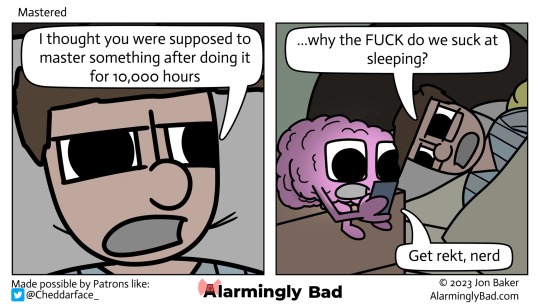
#10000 hours#learning skills#sleep#eepy little guy#i just want to sleep#comic#webcomic#alarmingly bad#funny#comic strip#relatable af#relatable comic#comics#drawing#digital comics
1 note
·
View note
Text
Hello and Good Day everyone!
I hope everyone has been well and has been able to work in their garden or towards any of their sustainable, self-sufficient or homestead journey this week :)
We've started getting what might be monsoon weather coming in. (Mostly just wind though. Some dirt. No rain though :'( )
The carrots I left to grow seed did some toppling.
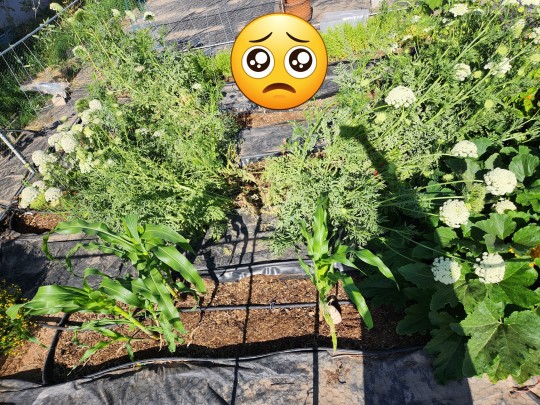
They were about 5+ ft tall (almost as tall as me!). Kind looks like someone sat down in between 'em and pushed em over lol
I've done a bit of doctoring to raise them up a bit. But not everyone was save-able. I knew a few weren't gonna make it, so i Figured I'd take the opportunity to show different stages of carrot flowers real close :)
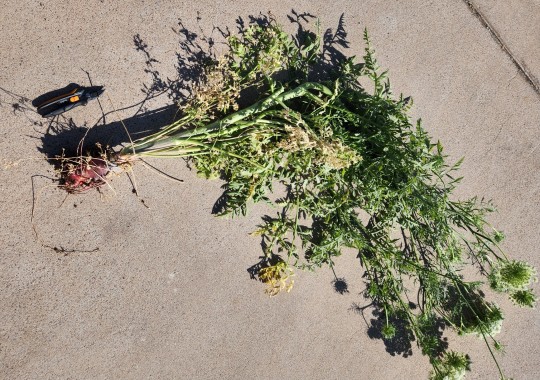
This is one of the unfortunate carrots I couldn't save. I was working on propping and heard it snap in the soil.

Check out that fat taproot! My soils isn't too deep (pipe concerns.) So I'm pretty sure it woulda been fine if the soil was deeper. I plan on cutting this open to show the different inner parts later :) I will not be eating this carrot, but instead will be giving it to my chickens.

This is the stem, it was about an inch round and at full height was about 4 ft tall.
The circled part I believe is called an intercalary node, the link below has more in depth info if you are curious and want to look up or know more :)
https://www.biologyonline.com/dictionary/intercalary-meristem

This pic has a few different flowering stages.
Some quick info,
A carrot flower is called an umbel and is a type of compound flower.
Each flower on the tip of the umbrella shaped structure has 5 petals and are white in color. (Thes petals fall off when they begin developing seeds)
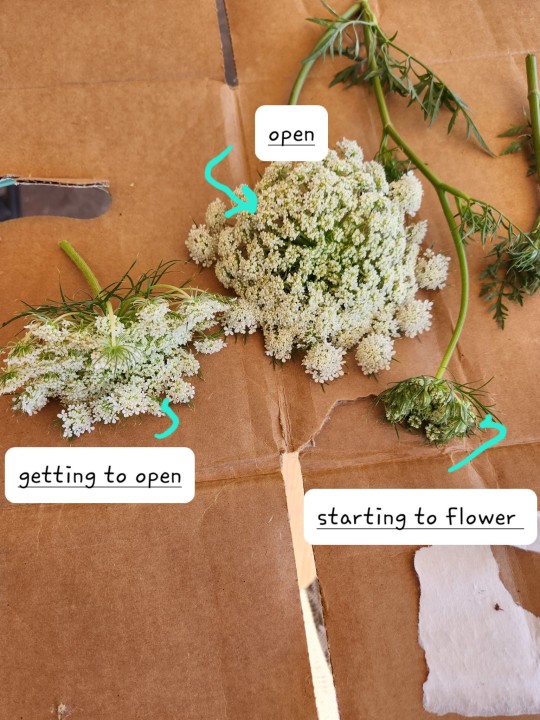
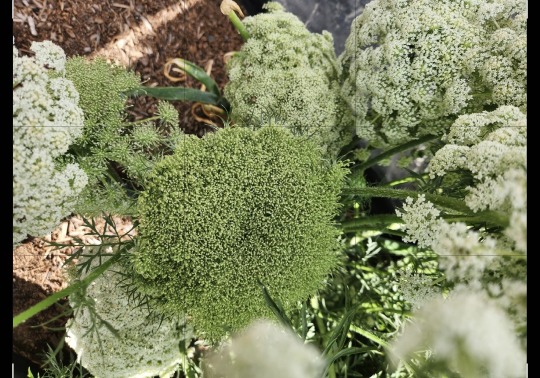
The kinda scraggly looking umbell in the center is losing its flower petals and seed is starting to come in! 🥳 as seed develops id suggest getting some organza bags or similar to keep them from falling to the ground. I still need to get some myself.
They, to me don't have much scent but are very pretty! And the variety of pollinators in the area love them.
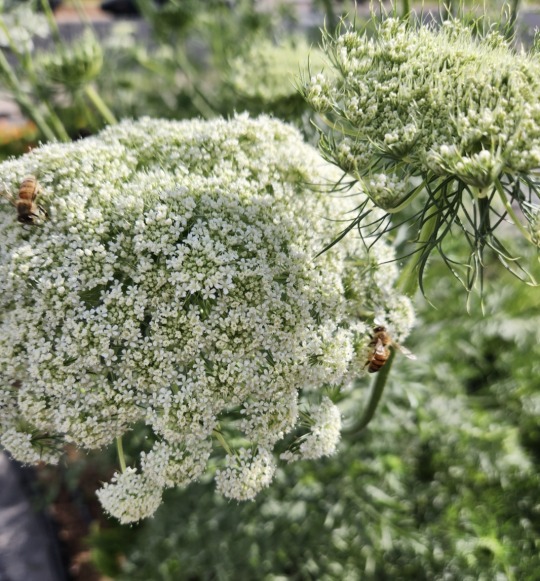
Plenty of bees, unfortunatly I haven't been able to catch pics of the butterflies yet!

And flies! I had to look it up but flies are pollinators species. Guess no fly traps in the garden for now.
And one last pic for today, this one's not a carrot but chard! I've not yet seen chard go to seed so this will be a fun learning experience :)

Definitely bolting action going on.
Bolting is when the weather changes too fast (usually seen when it gets too hot) and the plant panics and tries to seed as fast as it can.
I'll be keeping and eye on it and posting as it changes :)
That's it for now everyone, I hope you all ahve an amazing weekend!
🌱🥕Happy Seed saving! 🥕🌱
5 4 2023
#homesteading#self sufficient living#thestudentfarmer#studentfarmer#self sufficiency#food#garden#gardening#low waste#chickens#going to seed#seed saving#seed#next generation#learning skills#bolting#garden tips#small scale farming#urban gardening#small scale
26 notes
·
View notes
Text


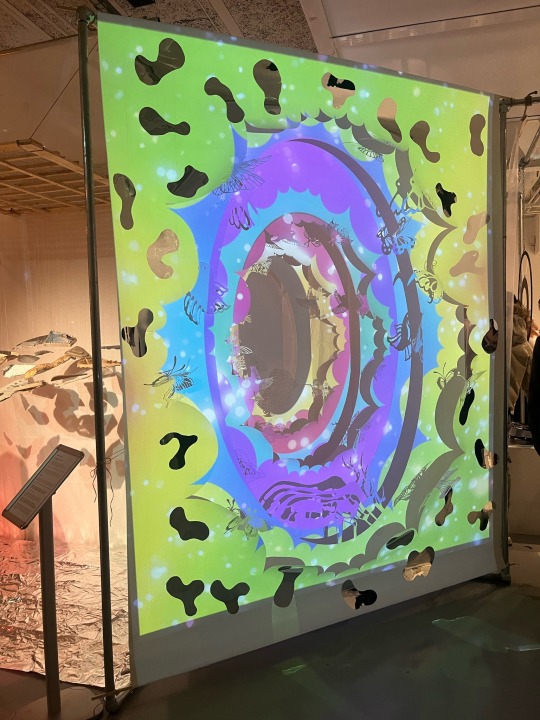







Final projection mapping studio project completed….
#my projects#projection mapping#architecture#development#learning skills#arts and crafts#building materials
0 notes
Text
Washing dishes is part cleaning up after ourselves!
0 notes
Text

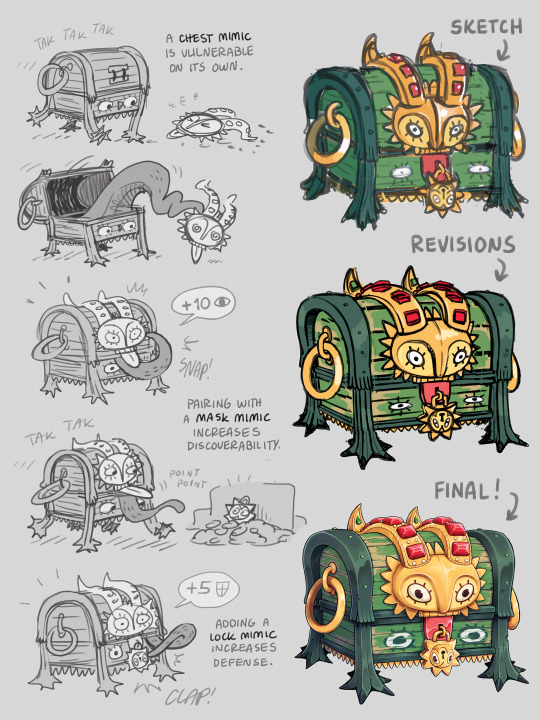


MIMICS!!!
#concept art#maybe i'm trying to learn new skills and make new art but i still gotta draw my silly little guys#mimic chest#fantasy art#mad rupert
4K notes
·
View notes